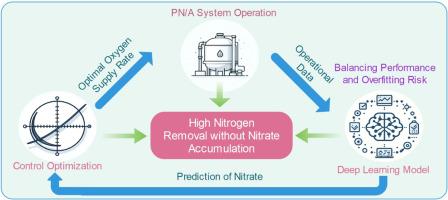当前位置:
X-MOL 学术
›
Water Res.
›
论文详情
Our official English website, www.x-mol.net, welcomes your
feedback! (Note: you will need to create a separate account there.)
Small-data-trained model for predicting nitrate accumulation in one-stage partial nitritation-anammox processes controlled by oxygen supply rate
Water Research ( IF 11.4 ) Pub Date : 2024-11-15 , DOI: 10.1016/j.watres.2024.122798 Zhenju Sun, Jianzheng Li, Jia Meng, Jiuling Li
Water Research ( IF 11.4 ) Pub Date : 2024-11-15 , DOI: 10.1016/j.watres.2024.122798 Zhenju Sun, Jianzheng Li, Jia Meng, Jiuling Li

|
Nitrate (NO3−-N) accumulation is the biggest obstacle for wastewater treatment via partial nitritation-anammox process. Dissolved oxygen (DO) control is the most used strategy to prevent NO3−-N accumulation, but the performance is usually unstable. This study proposes a novel strategy for controlling NO3−-N accumulation based on oxygen supply rate (OSR). In comparison, limiting the OSR is more effective than limiting DO in controlling NO3−-N accumulation through mathematical simulation. A laboratory-scale one-stage partial nitritation-anammox system was continuously operated for 135 days, which was divided into five stages with different OSRs. A novel deep learning model integrating Gated Recurrent Unit and Multilayer Perceptron was developed to predict NO3−-N accumulation load. To tackle with the general obstacle of limited environmental samples, a generic evaluation was proposed to optimise the model structure by leveraging predictive performance and overfitting risk. The developed model successfully predicted the NO3−-N accumulation in the system for ten days, showcasing its potential contribution to system design and performance enhancement.
中文翻译:

用于预测由供氧速率控制的一阶段部分硝化-厌氧氨氧化过程中硝酸盐积累的小数据训练模型
硝酸盐 (NO3−-N) 积累是通过部分硝化-厌氧氨氧化工艺处理废水的最大障碍。溶解氧 (DO) 控制是防止 NO3−-N 积累的最常用策略,但性能通常不稳定。本研究提出了一种基于供氧率 (OSR) 的 NO3−-N 积累的新策略。相比之下,通过数学模拟控制 NO3−-N 积累方面,限制 OSR 比限制 DO 更有效。实验室规模的一阶段部分硝化-厌氧氨氧化系统连续运行 135 天,分为具有不同 OSR 的五个阶段。开发了一种集成门控循环单元和多层感知器的新型深度学习模型来预测 NO3−-N 累积载荷。为了解决有限环境样本的一般障碍,提出了一种通用评估,通过利用预测性能和过拟合风险来优化模型结构。开发的模型成功预测了 NO3−-N 在系统中积累 10 天,展示了其对系统设计和性能增强的潜在贡献。
更新日期:2024-11-15
中文翻译:

用于预测由供氧速率控制的一阶段部分硝化-厌氧氨氧化过程中硝酸盐积累的小数据训练模型
硝酸盐 (NO3−-N) 积累是通过部分硝化-厌氧氨氧化工艺处理废水的最大障碍。溶解氧 (DO) 控制是防止 NO3−-N 积累的最常用策略,但性能通常不稳定。本研究提出了一种基于供氧率 (OSR) 的 NO3−-N 积累的新策略。相比之下,通过数学模拟控制 NO3−-N 积累方面,限制 OSR 比限制 DO 更有效。实验室规模的一阶段部分硝化-厌氧氨氧化系统连续运行 135 天,分为具有不同 OSR 的五个阶段。开发了一种集成门控循环单元和多层感知器的新型深度学习模型来预测 NO3−-N 累积载荷。为了解决有限环境样本的一般障碍,提出了一种通用评估,通过利用预测性能和过拟合风险来优化模型结构。开发的模型成功预测了 NO3−-N 在系统中积累 10 天,展示了其对系统设计和性能增强的潜在贡献。


















































 京公网安备 11010802027423号
京公网安备 11010802027423号